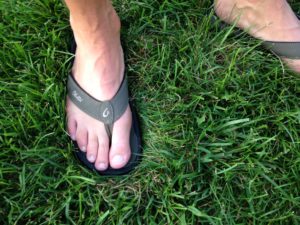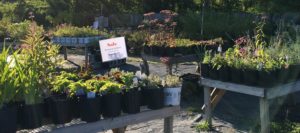Hello fellow readers,
We’ve had a brief hiatus from the heat and humidity, but its quick return has me weary. It occurs to me one of the biggest challenges in the garden of life is limited time. It’s true finding time in the garden is harder and harder as the summer unfolds. I blame it on peak work season. But the truth is, heat has something to do with it. Okay, a lot to do with it. Thankfully we are getting to the home stretch. Don’t you love the late summer sounds of insects reminding us its back to school time (sorry kids). And it’s time to return to our gardens.
 Michael of Delaware NJ asked if it’s a good time to seed bare patches in his lawn. Yes, indeedy. In late summer, nights become cooler and morning dew returns making it easier for seeds to germinate. Some say fall is better than spring to establish new lawns as well. The newly formed grass will have two growing seasons (fall and spring) to develop strong roots before the heat of summer. I recently chatted with turf guru Professor Craig Tolley in the Landscape and Horticultural Technology Department of County College of Morris. He shared that around Labor Day weekend is normally the best time to start the cool season grasses. He suggested doing a soil test first; as prior to seeding is an ideal time to correct pH or make additions of organic matter as needed. Your local Penn State and Rutgers University Extension offices have soil test kits and directions on how to.
Michael of Delaware NJ asked if it’s a good time to seed bare patches in his lawn. Yes, indeedy. In late summer, nights become cooler and morning dew returns making it easier for seeds to germinate. Some say fall is better than spring to establish new lawns as well. The newly formed grass will have two growing seasons (fall and spring) to develop strong roots before the heat of summer. I recently chatted with turf guru Professor Craig Tolley in the Landscape and Horticultural Technology Department of County College of Morris. He shared that around Labor Day weekend is normally the best time to start the cool season grasses. He suggested doing a soil test first; as prior to seeding is an ideal time to correct pH or make additions of organic matter as needed. Your local Penn State and Rutgers University Extension offices have soil test kits and directions on how to.
Fall is also a great time to plant woody plant material (a fancy way to say trees and shrubs) and some perennials too, especially if they’re bargains. Best to plant up to about six weeks prior to the hard frost to allow roots to become established before the ground freezes. I prefer planting between mid-September and the end of October. Planting into November can be fine too though it can be risky. Remember last year we were mild all fall and even had a seventy degree Christmas. Then – Bam! A frigid spell rolled in before plants became completely dormant. Plants suffered, especially those newly planted. And it wasn’t long ago Frosty the Snowman arrived for Halloween.
It’s likely best to avoid planting broad leaved evergreens in the fall. But if you opt to plant shrubs such as rhododendrons, boxwoods, and hollies, protect them from winter winds with an anti-desiccant such as Wilt-Pruf.
No more excuses. Get out and garden! (There I go talking to myself again.)
Garden Dilemmas? Askmarystone@gmail.com




